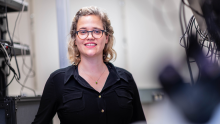UBC physicists have observed the pattern formed by a mysterious phenomenon that interferes with high-temperature superconductivity—discovering that it forms in a series of stripes, not a checkered pattern.
The discovery, just detailed in Science, settles a long-standing debate in the field.
The mysterious phenomenon, charge ordering, creates instability in metals at temperatures warmer than -100 degrees Celsius. It causes some electrons to reorganize into new periodical static patterns that compete with superconductivity. But scientists wonder if it may also play an essential role in propelling electrons into the tight pairs that allow them to travel without resistance.
In order to understand what charge ordering does, and whether it’s a hindrance, a help, or a bit of both, scientists must first understand what it is — starting with its shape.
By x-raying very cold yttrium barium copper oxide researchers found the pattern is striped, meaning the electrons self-organize along one direction rather than in two directions. However, when the temperature cools down far enough, charge ordering dies off and superconductivity takes over, allowing electrons to travel freely with no resistance, no longer constrained to one dimension.
"Physics is much more interesting in low dimensions,” says study co-author Andrea Damascelli. In the cuprates these 1D patterns are realized within the 2D Cu-O planes, which already constrain the motion of electrons to less than 3D, even before charge ordering sets in.
“Superconductivity in conventional 3D metals is limited to a transition temperature of few degrees Kelvin,” he says, citing examples such as aluminum and niobium. “High temperature superconductors are quasi 2D metals, and now with a tendency toward 1D electronic ordering.”
Researchers also found that charge ordering competes with superconductivity much more strongly along one direction than the other—an important step in understanding what drives superconductivity and what my hinder it.
“Is charge ordering just an anomaly, or is it there in all these systems because there is an underlying interaction which isn’t completely removed from superconductivity?” says study lead author Ricardo Comin, who led the work while at UBC. “The two phenomena are competing but in a sense they’re also interconnected.”
Damascelli says the material in this study, yttrium barium copper oxide, is the superstar of copper-oxides because of its exquisite purity and high transition temperature. It’s also a Canadian success story — CIFAR fellows Liang-Bonn-Hardy are leading growers and suppliers of the crystal for research the world over. “That’s why the Canadian groups and in particular the CIFAR program has had such an impact, because we had access to the best materials,” says Damascelli.


